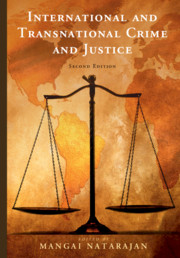Book contents
- International and Transnational Crime and Justice
- International and Transnational Crime and Justice
- Copyright page
- Contents
- Figures and Tables
- Preface
- About the Editor
- Notes on Contributors
- Introduction
- PART I OVERVIEW: TRANSNATIONAL CRIME
- PART II OVERVIEW: INTERNATIONAL CRIME
- PART IIA Core International Crimes (As Defined by the Rome Statute, 1998)
- PART IIB International Crime and Justice for Women and Children
- PART IIC International Justice
- 65 The Role of the United Nations
- 66 Treaties and International Law
- 67 The International Criminal Court
- 68 The ICC and the Darfur Investigation Progress and Challenges
- 69 Victims’ Rights in the International Criminal Court
- 70 International Criminal Tribunals and Hybrid Courts
- 71 Global and Regional Human Rights Commissions
- 72 The Truth and Reconciliation Commission in South Africa in Perspective Origins and Achievements
- 73 The Guatemalan Truth Commission Genocide Through the Lens of Transitional Justice
- 74 Nongovernmental Organizations and International Criminal Justice
- 75 Transforming Restorative Justice for Transitional Settings
- PART III OVERVIEW: INTERNATIONAL AND TRANSNATIONAL CRIME RESEARCH
- World Map
- Index
- References
75 - Transforming Restorative Justice for Transitional Settings
from PART IIC - International Justice
Published online by Cambridge University Press: 20 June 2019
- International and Transnational Crime and Justice
- International and Transnational Crime and Justice
- Copyright page
- Contents
- Figures and Tables
- Preface
- About the Editor
- Notes on Contributors
- Introduction
- PART I OVERVIEW: TRANSNATIONAL CRIME
- PART II OVERVIEW: INTERNATIONAL CRIME
- PART IIA Core International Crimes (As Defined by the Rome Statute, 1998)
- PART IIB International Crime and Justice for Women and Children
- PART IIC International Justice
- 65 The Role of the United Nations
- 66 Treaties and International Law
- 67 The International Criminal Court
- 68 The ICC and the Darfur Investigation Progress and Challenges
- 69 Victims’ Rights in the International Criminal Court
- 70 International Criminal Tribunals and Hybrid Courts
- 71 Global and Regional Human Rights Commissions
- 72 The Truth and Reconciliation Commission in South Africa in Perspective Origins and Achievements
- 73 The Guatemalan Truth Commission Genocide Through the Lens of Transitional Justice
- 74 Nongovernmental Organizations and International Criminal Justice
- 75 Transforming Restorative Justice for Transitional Settings
- PART III OVERVIEW: INTERNATIONAL AND TRANSNATIONAL CRIME RESEARCH
- World Map
- Index
- References
- Type
- Chapter
- Information
- International and Transnational Crime and Justice , pp. 456 - 460Publisher: Cambridge University PressPrint publication year: 2019
References
REFERENCES
WEBSITES
International Centre for Transitional Justice. www.ictj.org/search-results?search=re.
John Braithwaite: War, Crime and Regulation. http://johnbraithwaite.com/?s=restorative+justice.

